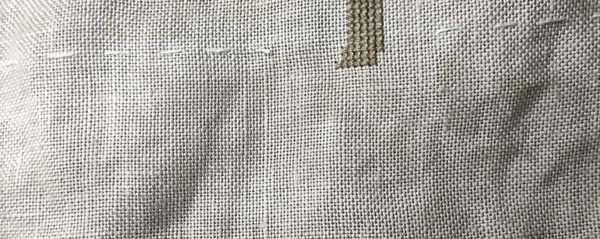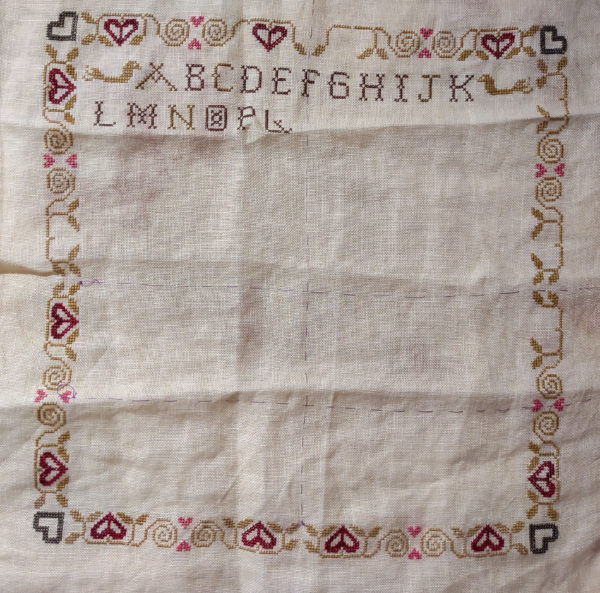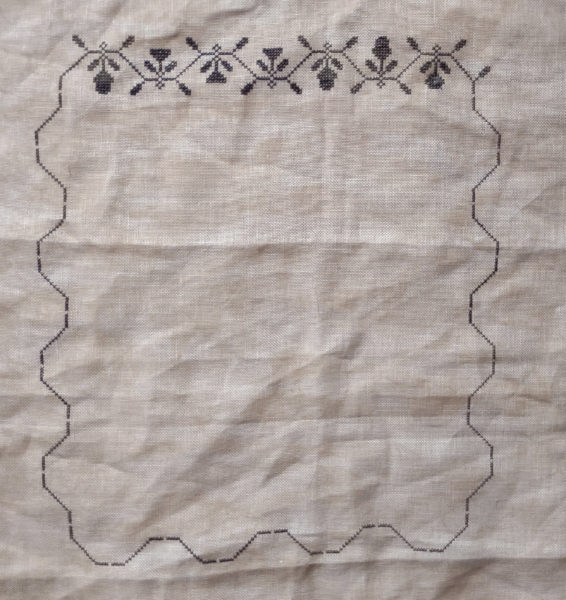Several have asked about gridding the fabric, which is where you would run a basting thread or colored thread every so many threads horizontally and vertically on the fabric to create a grid. With the grid lines, you would align those grid lines up with the darker grid lines on the chart. It definitely would make stitching easier in a lot of cases but it takes a long time and I found (the one time I did it), that I stitched into the grid thread and that made it hard to pull those threads out.
I’ll explain, hopefully clearly, what I do now. I use a thin poly thread (Superior’s Bottom Line) for my basting thread. It’s easy to pull out, has no fuzz and is slick and doesn’t snag on the linen.
If you’ve ever had to rip stitches out, you know fuzz or residue can be left behind and that can look like a shadow so be careful with the thread you’re using for basting those lines.
First, I will tell you this story. I’ve been calling the lines I put in “registration lines”. I asked my engineer husband “What do you think of when you think of a registration line?” He said “A line of people waiting to get their cars registered!” NO! Then I said “If you put a post in the ground and then you wanted to align the next post with it . . what would you call that line?” He started going into details about how an engineer would align two posts . . forget it . . the correct terminology may be “reference line” but whatever it is . . you hopefully know what I mean.
Honestly, it doesn’t matter what we call it, and it doesn’t matter how you do it . . what matters is that it’s helpful for you and helps get things aligned.

In the photo above, I ran a basting type thread, the white “reference line”, starting at a point in the right border design, all the way across to the left following the darker line on the chart (which happened to be the 120 mark on the chart). Once the basting line met the left border at the correct spot, I knew my borders were stitched correctly to that point. Then when I started stitching the green columns, I knew that the 9th row of green stitching should be sitting on that line.
You can see that I cut the basting thread and pulled out a few stitches so I wasn’t catching that thread with my green stitches.

In the piece shown above, I stitched a basting thread through the horizontal and vertical centers. I stitched the top border, then I stitched the vertical basting line from the center of the top border, down towards the bottom.
Then I stitched the left border to the halfway mark, ran a line from the left center to the right edge. Then I stitched the right border all the way down, then I stitched the bottom and worked my way up to the center of the left border.

For the border shown above, I stitched the left border first, then ran several horizontal basting lines towards the right to be sure the right side lined up with the left side. Once I knew the sides were correct, I stitched the bottom border. I removed the reference lines because the center of this piece is fairly easy to stitch and there shouldn’t be any problems with getting the placement correct. If I were doing this piece now, I would leave the lines in and remove them as I needed to, just so I wasn’t catching the basting thread in my stitching. There was no real advantage to removing those lines early and, they may have offered some amount of help.
I don’t try, for the most part, to line up my basting threads to match the grid lines on the chart. I’m more concerned about reference points on the border matching the same reference points on the top and bottom, or on the left or right side.
If this doesn’t make sense, please let me know. It would be easier to describe if I could use an actual chart but . . I can’t show those.

Nelle Coursey says
I like this idea and wish I had known about it a long time ago!
Cindy F says
I see the benefit of running several reference lines but haven’t done it yet. Going forward that will be my plan on some of the charts. There have been times I’ve had to recount spaces on my fabric multiple times because I lost track of where I needed to be. Thanks for the information and also the head’s up regarding what kind of thread to use!
Kathy Henderson says
Thank you Judy! I originally was thinking I would skip the reference lines, but now I’m leaning toward putting some in. A little extra work up front will most likely prevent some frustration later!!